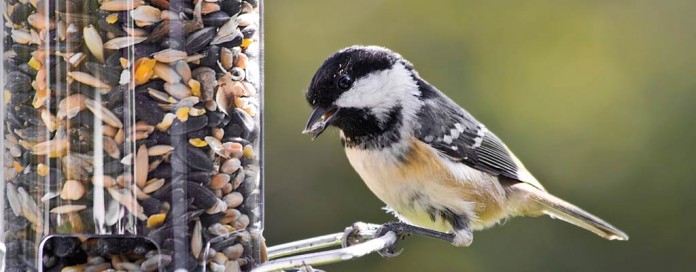Over the last 30 years, I’ve written dozens of columns about feeding backyard birds.
Based on my experiences, I’ve recommended specific foods (black-oil sunflower seeds, peanuts and mealworms) and specific feeders (tubes, hanging bowls and suet baskets).
My mission has always been to write what I know, so I wrote about attracting birds to the 95-acre slice of West Virginia heaven my wife and I called home.
During winter, I kept 25 to 30 feeders filled and could often count 20 species of birds visiting throughout the day. On particularly cold snowy days, I might see a few more species.
But that was then, and this is now. In the summer of 2018, we moved to an apartment community in western North Carolina.
Using small spaces
Our “backyard” now consists of a small patio and a 4-foot-wide mulched edge that borders two sides of the apartment.
It has been quite an adjustment. But our grandchildren are just 20 minutes away, and we can get to restaurants, a movie theater and a grocery store in less than ten minutes.
(Back in West Virginia, those destinations were an hour away.)
Shortly after we arrived, I cruised the apartment complex to look for evidence of birders. I found a handful of feeders and even saw some feeder birds, mostly house finches and blue jays.
I was further encouraged to discover mockingbirds, bluebirds, song sparrows and Carolina wrens scattered across the complex.
The challenge became how to attract an interesting variety of birds to our tiny patio.
Having brought many of my feeders and accessories along on the move, I began by using zip ties to strap several shepherd’s hooks to the railing surrounding the patio.
From those hooks, I hung tube feeders filled with black-oil sunflower seeds. Just beyond the patio I placed a bird bath complete with solar-powered fountain.
And outside my office window, I set a platform feeder on the mulch border and hung another tube just above it. Now I had to follow my own advice.
Whenever readers ask why birds seem to ignore new feeders, I always advise patience. To paraphrase a favorite movie quote, “Fill them, and they will come.”
By mid-September last year, house finches and song sparrows found the feeders. Then came titmice, Carolina wrens and an occasional Carolina chickadee.
Meanwhile, weeks earlier we had hung a nectar feeder for southbound ruby-throated hummingbirds. We recorded our first hummingbird on Labor Day weekend last year.
This spring we picked up a few northbound migrants, and most recently we’ve seen hummers every day since mid-August.
On Sept. 24, five hummers jousted for position at the feeders as they fueled up for points south. In early November, I plan to add a suet feeder to the patio.
Woodpeckers, chickadees, titmice, nuthatches and Carolina wrens love high-calorie animal fat to get them through long winter nights.
Apartment feeding tips
Obviously, I miss the diversity of species that visit my feeders here at the apartment, but I’ve tried to keep my expectations realistic.
Despite the well-manicured grounds and steady foot traffic that come with apartment life, I’m pleased with the birds I’ve seen over the last year.
If you live in a house with a tiny backyard, hang a single feeder and fill it with sunflower seeds. Birds never cease to amaze.
And if you’re an apartment dweller, a small seed tube or nectar feeder in a window box just might attract a few feathered friends.
No-melt peanut butter suet recipe
From Alabama friend Martha Sargent
- 1 cup crunchy peanut butter
- 2 cups “quick cook” oats
- 2 cups cornmeal
- 1 cup lard (no substitutes)
- 1 cup white flour
- 1/3 cup sugar
Melt lard and peanut butter over low heat, then stir in remaining ingredients. Pour into square or rectangular cake pan about 1.5 inches thick.
Place in freezer for 30 minutes to allow suet to harden a bit, then cut blocks to size to fit your suet basket. Separate blocks with wax paper; store in freezer in plastic bags.













